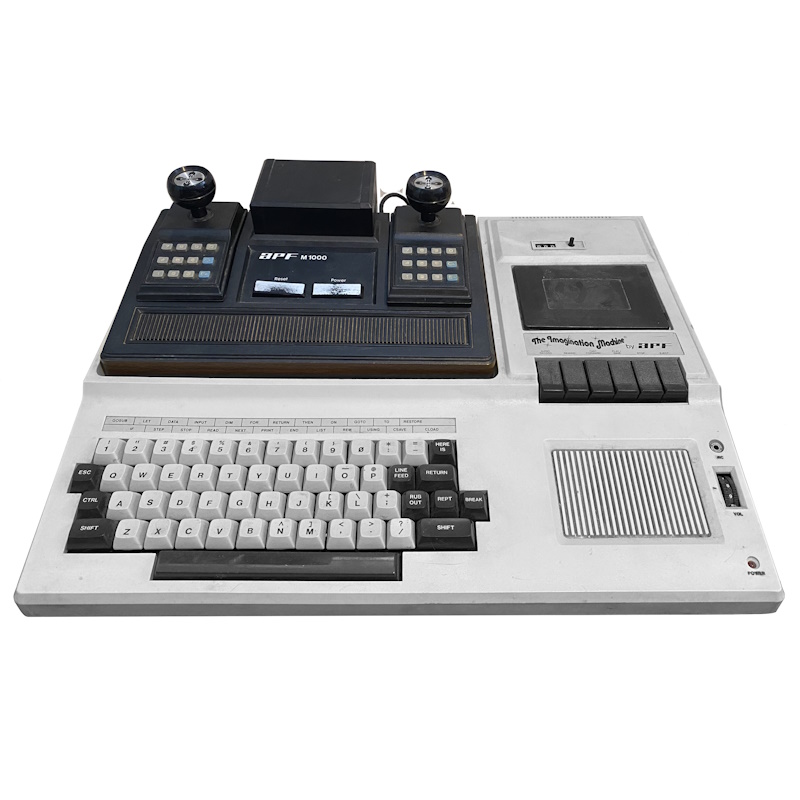|
History
During the conception of the MP1000, APF management heard that both Atari and Mattel were planning a computer add-on for their upcoming console. Around that time, Irving Boilen, APF’s head of engineering led the design of the PeCos One, the first personal computer made by APF. Short for Personal Computer One, the computer used the JOSS Language (an acronym for JOHNNIAC Open Shop System) instead of the popular BASIC language. Although this choice was not well received by the consumers and the PeCos One was quickly discontinued, this gave the necessary expertise to APF to go forward with another project : the Imagination Machine. Thinking that if they could be Atari to punch, they could get a bigger part of the cake, APF worked tirelessly on their new venture.
Release
By mid 1979, as the sales of the MP1000 were slowing down, APF were finally ready to release their personal computer extension. Almost a year after the release of their console, APF released the Imagination Machine. Although less powerful than the other personal computer of the time like the Apple II, the Imagination Machine was sold for $599, less than half the price of the Apple II. The Imagination Machine used the Motorola 6800 CPU of the MP1000 and came bundled with the console (renamed M1000). If you already had the console, you could purchase the Imagination Machine for $499. A lot of external peripherals like floppy drive and printer were also available from the stars.
Although well received by journalists, the Imagination Machine was not well received by the public. This is mostly due to the fact that APF decided to sell this computer using the same channel as the MP1000. This means that store clerks with no technical background and qualification were tasked to sell a fairly complex product. With no understanding of the inner work, customers were very uneasy to the idea of having a video game machine performing serious task like their personal finance. Another problem was the inclusion of a tape drive directly in the system. Apple had just released their Disk II Drive making the Imagination Machine fell a bit outdated. In the end, APF were able to move fewer than 20,000 units.
Demise
Wanting to distance themselves from the “toy” feel of the Imagination Machine, APF designed an updated version of the computer called the Imagination Machine II. The new models included the circuitry of the M1000 directly in the devices and added more memory, which makes the device look more professional. By January 1981, the Imagination Machine II was presented to the Consumer Electronic Show, but didn’t generate a lot of attention. APF had spent a lot of money in developing the MP1000 and the Imagination Machine and now had more than $7 million in debt. The bank didn’t think the Imagination Machine had a future especially since the release of the IBM Personal Computer in August 1981. The video game industry was still perceived as a fad so the bank asked APF to center their activity around the calculator line which was still successful or for the immediate reimbursement of the loan. The APF management refused to change their strategy and gave the company to the back which proceed in its foreclosure.
Games & Software
The marketing documents speak of 30 software for the Imagination Machine, but so far, they haven’t all been identified yet. As the Imagination Machine included a MP1000, it is possible that the documentation also included the MP1000‘s 12 cartridges and the built-in games of the system. Only three cartridges was released specifically for the Imagination Machine. All other software was on audio tape.
- Cartridge
- APF Basic
- Artist and Easel
- Budget Manager
- Audio Tapes
- [MA-125] Music Composer/Player Piano
- [MA-150] Typing Tutor
- [MA-200] Math Tutor
- [MA-225] Perception 1
- [MA-250] Space, Size and Surface Guide
- [MA-275] Personal Business Machine
- [MA-325] Artist and Easel
- [MA-350] Bar Charts
- [MA-375] The Word Factory
- [MA-400] Spelling Duel
- [MA-425] Electronic Files
- [MA-475] Billboard
- [MA-550] Jumbled Up Things
- [MA-575] Space Destroyers
- [MA-???] Lunar Lander
- [MA-???] Diagnostic
- [MA-???] Basic Tutor[MA-???] Computer Lab
- [MA-???] Adventure Castle
- [MA-???] Checkbook/Financial Manager
- [MA-???] Budget Manager II
- [MA-???] Demo8
Imagination Machine Peripherals
The Imagination Machine had several peripherals available on release day. The appeal of the Imagination Machine was its low cost. Adding multiple peripheral would make the price of the machine significantly higher which would make them a less appealing option than the high-end machine like the Apple II. Because of this, the peripheral for the systems are extremely rare.
- Building block $200—An extension needed to plug multiple peripherals.
- 8k ram addition $99.95
- Floppy interface $199.95
- Mini Floppy $349.95
- Printer $399.95
- Modem $199.95
- Basic ROM Cartridge $49.95
Technical Specifications
Since the Imagination Machine used the MP-1000/M-1000 CPU and RAM, their technical specification are identical except when noted otherwise.
- CPU: Motorola 6800
- Speed: 3.5 MHz
- RAM: 1 KB
- The imagination machine has an additional 8 KB of RAM (for a total of 9 KB)
- This can be extended to 16 KB (for a total of 17 KB)
- Resolution: 256 x 192 pixels / 32 x 16 characters, 8 Colors

